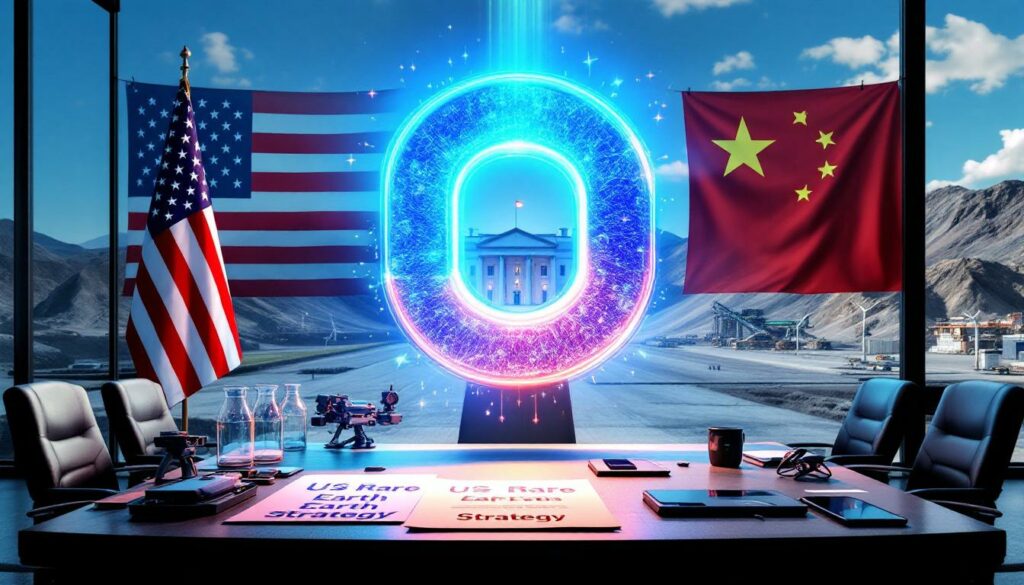US Rare Earth Strategy: Addressing Chinese Dependency Through White House Initiatives
The United States government has recognized the strategic vulnerability of relying on Chinese rare earth supplies and is actively developing comprehensive initiatives to address this dependency. Recent actions by the Trump administration highlight a growing awareness of this critical issue, with concrete steps being taken to establish domestic production and processing capabilities.
Understanding the Strategic Framework
The US government's rare earth strategy encompasses multiple approaches to reduce dependency on Chinese supplies while building resilient domestic capabilities. This multifaceted approach includes direct government investments, price support mechanisms, and initiatives to develop complete supply chains within US borders.
According to Bloomberg News, the Trump administration is committed to "creating a commercially viable environment to incubate the industry, including protective tariffs and price floors." This represents a significant shift in industrial policy, acknowledging the critical nature of these materials to national security and economic competitiveness.
The strategy includes:
- Implementation of price floor guarantees to ensure economic viability for domestic producers
- Strategic government investments targeting key points in the supply chain
- Development of recycling infrastructure to diversify supply sources
- Potential export restrictions on electronic waste to retain valuable materials domestically
- Focus on establishing complete supply chains from mining to finished products
Why are Rare Earth Elements Strategically Important?
Rare earth elements comprise a group of 17 metallic elements that, despite their name, are relatively abundant in the Earth's crust. Their unique properties make them irreplaceable in numerous high-tech and defense applications, creating a strategic vulnerability when supplies are concentrated in a single region.
Critical Applications Across Industries
These elements play an essential role in numerous sectors vital to both economic prosperity and national security:
- Defense Technology: Rare earth magnets are critical components in missile guidance systems, radar equipment, and other military hardware
- Renewable Energy: Wind turbines and solar panels rely on rare earth elements for efficient operation as part of the critical minerals energy transition
- Consumer Electronics: Smartphones, computers, and home appliances require rare earth components
- Automotive Manufacturing: Both conventional vehicles and electric vehicles depend on rare earth elements
- Industrial Applications: Various high-tech industrial processes and equipment utilize these materials
Exposed Vulnerabilities in Global Supply Chains
The strategic importance of rare earth elements became painfully apparent during recent trade tensions between the US and China. As Bloomberg News reported, China "controls global production" of these critical materials and demonstrated its willingness to use this leverage by imposing "export controls in retaliation for US tariff threats" which "left companies warning they'd have to suspend production."
This episode exposed critical vulnerabilities:
- China's dominant position controlling approximately 85% of global rare earth processing
- Limited alternative sources available outside Chinese control
- Manufacturing disruptions threatened when supplies were restricted
- Recycling infrastructure predominantly located within China
- US dependency creating significant economic and security vulnerabilities
The situation was only resolved when "China agreed to resume shipments after the US agreed not to impose the higher import levies," demonstrating the leverage that China export controls impact provides in international negotiations.
What Actions Has the White House Taken on Rare Earth Elements?
The trump team outlines push for rare earths in meeting with executives through several concrete steps to address the rare earth supply challenge, recognizing both the urgency and complexity of the situation.
High-Level Strategic Planning
Trade adviser Peter Navarro recently "convened a meeting" with "top technology and recycling companies" to discuss rare earth production strategies, according to Bloomberg News reporting. This meeting signals the administration's commitment to addressing this vulnerability through coordinated action.
Meeting participants "came away from the session with the impression the administration is alarmed about the vulnerability that the lack of alternatives to Chinese supplies presents," highlighting the urgency with which officials are approaching this issue.
Strategic Investment in Domestic Production
The most significant concrete action to date has been the Department of Defense announcement of a "$400 million equity stake in MP Materials Corp," identified as "the only US rare earth producer." This investment includes "government-guaranteed minimum prices" to ensure economic viability.
As Navarro explained, "The MP rare earths deal is an essential part of an overall strategy to onshore critical minerals of which rare earths is just one part. Our goal is to build out our supply chains from mines to end use products across the entire critical mineral spectrum."
Additional initiatives include:
- Development of protective tariff structures to shield emerging domestic industry
- Exploration of waste export restrictions to retain recyclable materials
- Focus on both mining and recycling approaches to diversify supply
- Implementation of price floors to ensure economic viability
How Does the US Plan to Develop Domestic Rare Earth Production?
The administration's approach to developing domestic rare earth production follows two parallel paths: mining development and recycling initiatives. This dual approach recognizes both the urgency of establishing domestic supply and the time required to develop new mining operations.
Mining Development Strategy
The cornerstone of the mining development strategy is the $400 million equity investment in MP Materials, which operates the Mountain Pass mine in California. This investment aims to support the only active rare earth mining operation in the United States while providing financial guarantees that make continued operation economically viable.
Key elements of the mining strategy include:
- Price floor guarantees to ensure production remains economically viable
- Strategic investments in existing mining operations
- Protective tariffs to shield domestic producers from international competition
- Focus on developing complete domestic supply chains
- Creation of a "commercially viable environment to incubate the industry"
Recycling Initiatives as a Parallel Approach
Recognizing that developing new mining operations requires significant time, the administration is simultaneously pursuing battery recycling process initiatives that could deliver results more quickly. According to Bloomberg News, officials have noted that recycling "could bring production online faster than mine projects currently in the works."
The recycling strategy includes potential policy changes such as "banning the export of electronic waste to keep material for recycling in the US." This would address the current situation where "most of the reprocessing needed to extract the magnets is done in China."
Recycling offers several advantages:
- Faster implementation timeline compared to new mining operations
- Reduced environmental impact compared to new extraction
- Utilization of existing waste streams as resource inputs
- Retention of valuable materials within the domestic economy
- Diversification of supply sources beyond mining
What Challenges Does the US Rare Earth Strategy Face?
Despite ambitious plans and significant financial commitments, the US rare earth strategy faces substantial challenges that could impact implementation timelines and overall effectiveness.
Industry Development Hurdles
Building a competitive domestic rare earth industry involves overcoming significant technical, economic, and regulatory challenges:
- Technical expertise for rare earth processing is limited within the US
- Processing facilities require substantial capital investment
- Environmental permitting for new extraction can be time-consuming
- Achieving cost competitiveness with established Chinese operations is difficult
- Building complete supply chains requires coordinated development across multiple sectors
Competitive Landscape Concerns
The administration's approach has raised concerns about competitive dynamics within the emerging domestic industry. According to Bloomberg News, "Some participants in the meeting with Navarro expressed concern that the MP deal may prevent the emergence of vibrant competitors in the sector."
This highlights the tension between providing sufficient support to establish viable domestic production and creating a healthy competitive landscape:
- Risk of creating monopolistic structures through concentrated investment
- Need for balanced approach to encourage multiple suppliers
- Potential barriers to entry for new competitors
- Challenge of distributing limited government resources effectively
- Balancing immediate needs with long-term industry health
How Urgent is the Rare Earth Supply Situation?
The administration's actions indicate a high level of concern about the strategic vulnerability created by dependence on Chinese rare earth supplies, with recent events demonstrating the immediate nature of the threat.
Administration's Assessment of Vulnerability
Meeting participants reported that "the administration is alarmed about the vulnerability that the lack of alternatives to Chinese supplies presents," according to Bloomberg News. This assessment has driven the urgency behind recent initiatives.
The focus on technical details of implementation, particularly regarding recycling approaches that could deliver faster results, further indicates the administration's view that this vulnerability requires immediate attention.
Recent Supply Disruptions Demonstrate Risk
The recent experience with Chinese export controls provides a concrete example of the supply chain risks facing US manufacturers. As Bloomberg News reported, China "imposed export controls in retaliation for US tariff threats" which "left companies warning they'd have to suspend production."
This episode demonstrates:
- The real-world consequences of supply chain vulnerability
- China's willingness to leverage rare earth supply as a negotiating tool
- The direct impact on manufacturing operations when supplies are restricted
- The limited options available to US companies during supply disruptions
- The strategic advantage provided by control of critical materials
What is the Role of Recycling in the US Rare Earth Strategy?
Recycling represents a potentially faster pathway to establishing domestic rare earth processing capacity compared to developing new mining operations, making it a critical component of the administration's strategy.
Recycling as a Strategic Priority
The administration has identified recycling as a key component of its rare earth strategy, with officials noting that this approach "could bring production online faster than mine projects currently in the works." This recognition of recycling's strategic importance was evident in the recent White House meeting, where "officials discussed the technical details of recycling of the magnets."
Policy Considerations for Recycling Development
To support domestic recycling capabilities, the administration is considering policy changes that would retain recyclable materials within US borders. According to Bloomberg News, officials are discussing "the possibility of banning the export of electronic waste to keep material for recycling in the US."
This approach addresses a critical gap in the current system, where "most of the reprocessing needed to extract the magnets is done in China." By keeping these materials within US borders, the administration aims to create opportunities for domestic recycling operations.
The recycling strategy offers several advantages:
- Shorter implementation timeline compared to new mining operations
- Reduced environmental footprint compared to primary extraction
- Utilization of existing waste streams that currently leave the country
- Development of new domestic industry and associated jobs
- Retention of valuable materials within the US economy
Disclaimer: The rare earth market is subject to significant geopolitical and economic volatility. The strategic initiatives outlined in this article represent current policy directions that may change over time. Investments in this sector carry substantial risks and should be evaluated carefully.
FAQ: US Rare Earth Strategy
What are rare earth elements and why are they important?
Rare earth elements are a group of 17 metallic elements that, despite their name, are relatively abundant in the Earth's crust. They are crucial for manufacturing permanent magnets used in everything from smartphones and wind turbines to military equipment. Their unique properties make them essential for many high-tech applications, and currently, there are few viable substitutes.
How dependent is the US on Chinese rare earth supplies?
The US is heavily dependent on Chinese rare earth supplies, with China controlling approximately 85% of global processing capacity. This dependency creates significant supply chain vulnerabilities, as demonstrated during recent trade tensions when China implemented export controls that threatened manufacturing operations.
What is MP Materials and what role does it play in US rare earth strategy?
MP Materials is the only active rare earth producer in the United States, operating the Mountain Pass mine in California. The company has received a $400 million equity investment from the Department of Defense as part of the administration's strategy to develop domestic supply chains. The deal includes government-guaranteed minimum prices to ensure economic viability.
How long will it take to develop a robust US rare earth supply chain?
Developing a complete domestic rare earth supply chain will likely take several years. Mining operations require significant time for permitting, construction, and reaching full production capacity. Recycling initiatives may provide faster results but still require infrastructure development. The administration appears to be pursuing both short-term and long-term solutions simultaneously.
What are the environmental considerations in rare earth production?
Rare earth mining and processing can have significant environmental impacts, including the generation of toxic waste and radioactive byproducts. Developing domestic production will require addressing these environmental challenges through improved technologies and regulatory frameworks. Recycling offers environmental advantages by reducing the need for new extraction.
Looking Beyond Current Initiatives
While the current focus is on establishing immediate domestic production capabilities, longer-term strategies will need to address additional challenges:
- Research and Development: Developing alternatives to rare earth elements or more efficient use technologies
- International Partnerships: Creating supply agreements with allied nations to further diversify sources
- Education and Workforce Development: Building the technical expertise needed for a domestic industry
- Advanced Recycling Technologies: Improving recovery rates and economic viability of recycling operations
- Regulatory Framework Development: Creating appropriate oversight while enabling industry growth
As the trump team outlines push for rare earths in meeting with executives, these initiatives represent just the beginning of what will necessarily be a long-term commitment to securing these critical supply chains. Furthermore, Trump's critical minerals order demonstrates the administration's commitment to addressing vulnerabilities in the supply chain, which is part of the broader mining industry evolution happening globally.
Ready to Spot the Next Major Mineral Discovery?
Discovery Alert's proprietary Discovery IQ model identifies significant ASX mineral discoveries in real-time, turning complex data into actionable investment insights. Explore why major discoveries can lead to exceptional market returns by visiting Discovery Alert's dedicated discoveries page and position yourself ahead of the market.




